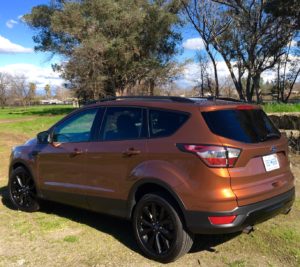Small crossover sport utility vehicles can be the choice for just about anyone because of their versatility, driving acumen, performance, gas mileage, and pleasing exterior appearance.
These days there are many people on the roadways in compact SUVs: moms, senior citizens, teenage drivers, and dads who want to downsize. Labeling the Ford Escape as an appealing SUV should not come as a surprise to anyone, judging from the number of people driving the popular compact these days.

The 2017 Ford Escape is a solid choice, but the competition is fierce. Among the other choices are Honda CR-V, Hyundai Tucson, Mazda CX-5, Kia Sportage, Mitsubishi Outlander Sport, and Toyota RAV4.
Since test driven here two years ago, the major changes include two new engines unveiled in 2017, a revised exterior, and the “Synch 3” infotainment system that replaced the unpopular MyFord Touch in 2016. The new Escape was given a little facelift and the tail was tweaked.
The Escape retains its sleek look and isn’t nearly as boxy as older models.
Ford’s most popular SUV employs two EcoBoost engines in the Escape lineup for 2017. The EcoBoost is a family of turbocharged, direct-injection gasoline engines produced by Ford. The holdover engine for the Escape is a standard 2.5-liter, inline-4 that produces168 horsepower and 170 pound-feet of torque. We’re fans of the turbo models, so the 2.5-liter would not be our preference.
The Escape has a smaller turbocharged 1.5-liter, inline-4 that generates 179 horsepower and 177-pound-feet of torque. The fastest of the three engines is the engaging turbo-powered 2.0-liter, inline-4 that elicits 245 horsepower and 275 pound-feet of torque.
Surprisingly, there’s not much difference in the gas mileage for the three engine types, ranging is from 22-30 mpg. The turbo models both feature the fuel-saving stop-start technology. When the Escape comes to a full stop, the gas mileage savings begins. Even with that feature, it’s interesting to note that compared to the competition, the gas mileage figures for the Escape are on the low side.
With the exception of the larger turbo model, the Escape offers no thrills from a driving standpoint. But Ford has done an admirable job of creating a somewhat sophisticated ride and the handling is solid. The lesser performance models can labor a bit climbing hills at times, yet are very good as commuter vehicles for less active people that don’t frequently head into mountainous areas.
The Escape interior is stylish and offers solid room and comfort. Practically every touch surface has been revised and the look and feel is improved. There is now an electronic parking brake and the result is the center console is better positioned.
2017 Ford Escape
- Performance: 2.5-liter, four-cylinder, 168 horsepower; turbocharged 1.5-liter, four-cylinder, 179 horsepower; turbocharged 2.0-liter, four-cylinder, 245 horsepower
- Mileage estimate range: 21-28 mpg; 22-30 mpg; 22-29 mpg
- Estimated price: $23,750 to $29, 995
- Warranty: 3 years/36,000 miles; drivetrain 5 years/60,000 miles; corrosion 5 years/unlimited; roadside assistance 5 years/60,000
The seating in the Escape provides good padding and comfort, and the gauges are sizable and simple to read. The cargo area is a roomy 34 cubic feet and the storage expands to 68 cubic feet with the backseat folded.
The Escape is one of the top-selling models in its class because it’s a refined compact SUV that meets the needs the needs for a diverse class of car buyers.
Jeffrey Weidel can be reached at [email protected]. Follow him on Twitter at @jeffweidel. His “Weidel on Wheels” auto reviews are featured periodically on this website at www.tahoeskiworld.com.